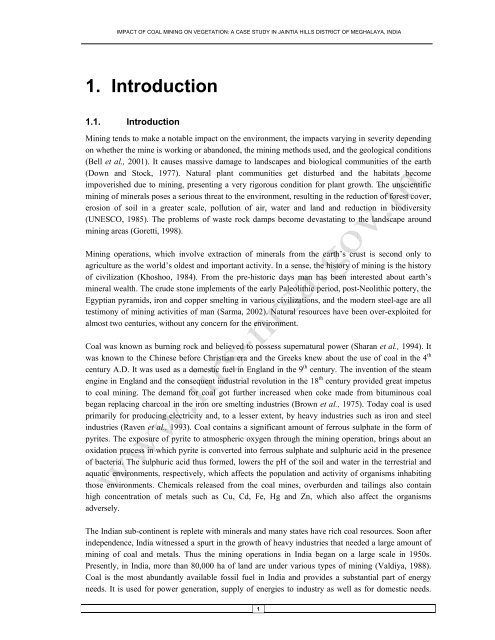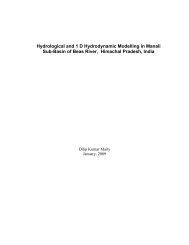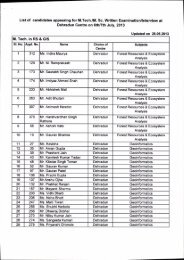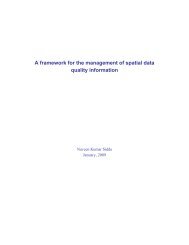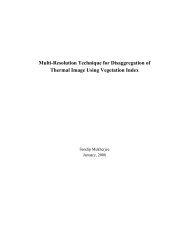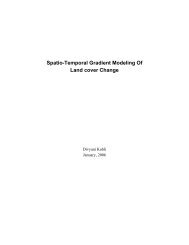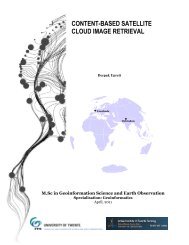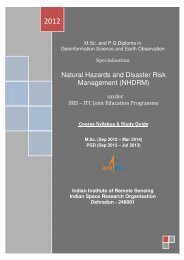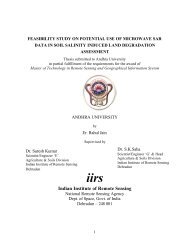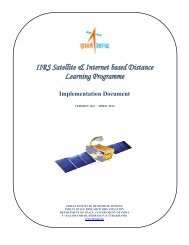IMPACT OF COAL MINING ON VEGETATION: A CASE STUDY IN JAINTIA HILLS DISTRICT OF MEGHALAYA, INDIA1. Introducti<strong>on</strong>1.1. Introducti<strong>on</strong><str<strong>on</strong>g>M<strong>in</strong><strong>in</strong>g</str<strong>on</strong>g> tends to make a notable impact <strong>on</strong> the envir<strong>on</strong>ment, the impacts vary<strong>in</strong>g <strong>in</strong> severity depend<strong>in</strong>g<strong>on</strong> whether the m<strong>in</strong>e is work<strong>in</strong>g or aband<strong>on</strong>ed, the m<strong>in</strong><strong>in</strong>g methods used, and the geological c<strong>on</strong>diti<strong>on</strong>s(Bell et al., 2001). It causes massive damage to landscapes and biological communities <str<strong>on</strong>g>of</str<strong>on</strong>g> the earth(Down and Stock, 1977). Natural plant communities get disturbed and the habitats becomeimpoverished due to m<strong>in</strong><strong>in</strong>g, present<strong>in</strong>g a very rigorous c<strong>on</strong>diti<strong>on</strong> for plant growth. The unscientificm<strong>in</strong><strong>in</strong>g <str<strong>on</strong>g>of</str<strong>on</strong>g> m<strong>in</strong>erals poses a serious threat to the envir<strong>on</strong>ment, result<strong>in</strong>g <strong>in</strong> the reducti<strong>on</strong> <str<strong>on</strong>g>of</str<strong>on</strong>g> forest cover,erosi<strong>on</strong> <str<strong>on</strong>g>of</str<strong>on</strong>g> soil <strong>in</strong> a greater scale, polluti<strong>on</strong> <str<strong>on</strong>g>of</str<strong>on</strong>g> air, water and land and reducti<strong>on</strong> <strong>in</strong> biodiversity(UNESCO, 1985). The problems <str<strong>on</strong>g>of</str<strong>on</strong>g> waste rock damps become devastat<strong>in</strong>g to the landscape aroundm<strong>in</strong><strong>in</strong>g areas (Goretti, 1998).<str<strong>on</strong>g>M<strong>in</strong><strong>in</strong>g</str<strong>on</strong>g> operati<strong>on</strong>s, which <strong>in</strong>volve extracti<strong>on</strong> <str<strong>on</strong>g>of</str<strong>on</strong>g> m<strong>in</strong>erals from the earth’s crust is sec<strong>on</strong>d <strong>on</strong>ly toagriculture as the world’s oldest and important activity. In a sense, the history <str<strong>on</strong>g>of</str<strong>on</strong>g> m<strong>in</strong><strong>in</strong>g is the history<str<strong>on</strong>g>of</str<strong>on</strong>g> civilizati<strong>on</strong> (Khoshoo, 1984). From the pre-historic days man has been <strong>in</strong>terested about earth’sm<strong>in</strong>eral wealth. The crude st<strong>on</strong>e implements <str<strong>on</strong>g>of</str<strong>on</strong>g> the early Paleolithic period, post-Neolithic pottery, theEgyptian pyramids, ir<strong>on</strong> and copper smelt<strong>in</strong>g <strong>in</strong> various civilizati<strong>on</strong>s, and the modern steel-age are alltestim<strong>on</strong>y <str<strong>on</strong>g>of</str<strong>on</strong>g> m<strong>in</strong><strong>in</strong>g activities <str<strong>on</strong>g>of</str<strong>on</strong>g> man (Sarma, 2002). Natural resources have been over-exploited foralmost two centuries, without any c<strong>on</strong>cern for the envir<strong>on</strong>ment.<str<strong>on</strong>g>Coal</str<strong>on</strong>g> was known as burn<strong>in</strong>g rock and believed to possess supernatural power (Sharan et al., 1994). Itwas known to the Ch<strong>in</strong>ese before Christian era and the Greeks knew about the use <str<strong>on</strong>g>of</str<strong>on</strong>g> coal <strong>in</strong> the 4 thcentury A.D. It was used as a domestic fuel <strong>in</strong> England <strong>in</strong> the 9 th century. The <strong>in</strong>venti<strong>on</strong> <str<strong>on</strong>g>of</str<strong>on</strong>g> the steameng<strong>in</strong>e <strong>in</strong> England and the c<strong>on</strong>sequent <strong>in</strong>dustrial revoluti<strong>on</strong> <strong>in</strong> the 18 th century provided great impetusto coal m<strong>in</strong><strong>in</strong>g. The demand for coal got further <strong>in</strong>creased when coke made from bitum<strong>in</strong>ous coalbegan replac<strong>in</strong>g charcoal <strong>in</strong> the ir<strong>on</strong> ore smelt<strong>in</strong>g <strong>in</strong>dustries (Brown et al., 1975). Today coal is usedprimarily for produc<strong>in</strong>g electricity and, to a lesser extent, by heavy <strong>in</strong>dustries such as ir<strong>on</strong> and steel<strong>in</strong>dustries (Raven et al., 1993). <str<strong>on</strong>g>Coal</str<strong>on</strong>g> c<strong>on</strong>ta<strong>in</strong>s a significant amount <str<strong>on</strong>g>of</str<strong>on</strong>g> ferrous sulphate <strong>in</strong> the form <str<strong>on</strong>g>of</str<strong>on</strong>g>pyrites. The exposure <str<strong>on</strong>g>of</str<strong>on</strong>g> pyrite to atmospheric oxygen through the m<strong>in</strong><strong>in</strong>g operati<strong>on</strong>, br<strong>in</strong>gs about anoxidati<strong>on</strong> process <strong>in</strong> which pyrite is c<strong>on</strong>verted <strong>in</strong>to ferrous sulphate and sulphuric acid <strong>in</strong> the presence<str<strong>on</strong>g>of</str<strong>on</strong>g> bacteria. The sulphuric acid thus formed, lowers the pH <str<strong>on</strong>g>of</str<strong>on</strong>g> the soil and water <strong>in</strong> the terrestrial andaquatic envir<strong>on</strong>ments, respectively, which affects the populati<strong>on</strong> and activity <str<strong>on</strong>g>of</str<strong>on</strong>g> organisms <strong>in</strong>habit<strong>in</strong>gthose envir<strong>on</strong>ments. Chemicals released from the coal m<strong>in</strong>es, overburden and tail<strong>in</strong>gs also c<strong>on</strong>ta<strong>in</strong>high c<strong>on</strong>centrati<strong>on</strong> <str<strong>on</strong>g>of</str<strong>on</strong>g> metals such as Cu, Cd, Fe, Hg and Zn, which also affect the organismsadversely.The Indian sub-c<strong>on</strong>t<strong>in</strong>ent is replete with m<strong>in</strong>erals and many states have rich coal resources. So<strong>on</strong> after<strong>in</strong>dependence, India witnessed a spurt <strong>in</strong> the growth <str<strong>on</strong>g>of</str<strong>on</strong>g> heavy <strong>in</strong>dustries that needed a large amount <str<strong>on</strong>g>of</str<strong>on</strong>g>m<strong>in</strong><strong>in</strong>g <str<strong>on</strong>g>of</str<strong>on</strong>g> coal and metals. Thus the m<strong>in</strong><strong>in</strong>g operati<strong>on</strong>s <strong>in</strong> India began <strong>on</strong> a large scale <strong>in</strong> 1950s.Presently, <strong>in</strong> India, more than 80,000 ha <str<strong>on</strong>g>of</str<strong>on</strong>g> land are under various types <str<strong>on</strong>g>of</str<strong>on</strong>g> m<strong>in</strong><strong>in</strong>g (Valdiya, 1988).<str<strong>on</strong>g>Coal</str<strong>on</strong>g> is the most abundantly available fossil fuel <strong>in</strong> India and provides a substantial part <str<strong>on</strong>g>of</str<strong>on</strong>g> energyneeds. It is used for power generati<strong>on</strong>, supply <str<strong>on</strong>g>of</str<strong>on</strong>g> energies to <strong>in</strong>dustry as well as for domestic needs.1
IMPACT OF COAL MINING ON VEGETATION: A CASE STUDY IN JAINTIA HILLS DISTRICT OF MEGHALAYA, INDIAIndia is highly dependent <strong>on</strong> coal for meet<strong>in</strong>g its commercial energy requirements. India ranks thethird largest coal producer <str<strong>on</strong>g>of</str<strong>on</strong>g> the world next <strong>on</strong>ly to Ch<strong>in</strong>a and USA. <str<strong>on</strong>g>Coal</str<strong>on</strong>g> m<strong>in</strong><strong>in</strong>g <strong>in</strong> India was started<strong>in</strong> the year 1774 <strong>in</strong> the state <str<strong>on</strong>g>of</str<strong>on</strong>g> West Bengal. At the beg<strong>in</strong>n<strong>in</strong>g <str<strong>on</strong>g>of</str<strong>on</strong>g> 20th century, the total producti<strong>on</strong> <str<strong>on</strong>g>of</str<strong>on</strong>g>coal was just about 6 milli<strong>on</strong> t<strong>on</strong>nes per year. The producti<strong>on</strong> was 154.30 milli<strong>on</strong> t<strong>on</strong>es <strong>in</strong> 1985-86 andit reached 298 milli<strong>on</strong> t<strong>on</strong>nes <strong>in</strong> the year 1997-98. The expectati<strong>on</strong> to reach the producti<strong>on</strong> <str<strong>on</strong>g>of</str<strong>on</strong>g> coal by2000 A.D. was 417 milli<strong>on</strong> t<strong>on</strong>nes (<str<strong>on</strong>g>Coal</str<strong>on</strong>g> India, 1997).In north-east India, coal m<strong>in</strong><strong>in</strong>g was <strong>in</strong>itiated by Medlicott <strong>in</strong> 1869 and 1874. Some coal occurrences<strong>in</strong> Ja<strong>in</strong>tia <strong>Hills</strong> were exam<strong>in</strong>ed by shallow drill<strong>in</strong>g by Dias <strong>in</strong> 1962-63 and Goswami and Dhara <strong>in</strong>1963-64 (Bullet<strong>in</strong> <str<strong>on</strong>g>of</str<strong>on</strong>g> Geological Survey <str<strong>on</strong>g>of</str<strong>on</strong>g> India, 1969). Commercial exploitati<strong>on</strong> <str<strong>on</strong>g>of</str<strong>on</strong>g> coal <strong>in</strong>Meghalaya started <strong>in</strong> the Khasi <strong>Hills</strong> dur<strong>in</strong>g the 19th century. S<strong>in</strong>ce most <str<strong>on</strong>g>of</str<strong>on</strong>g> the coal deposits weresmall and isolated and it was not amenable for scientific m<strong>in</strong><strong>in</strong>g to be c<strong>on</strong>ducted <strong>in</strong> the organizedsector and m<strong>in</strong><strong>in</strong>g operati<strong>on</strong>s were left to the local m<strong>in</strong>ers to take up coal m<strong>in</strong><strong>in</strong>g as a cottage <strong>in</strong>dustry.In due course <str<strong>on</strong>g>of</str<strong>on</strong>g> time, the tribal m<strong>in</strong>ers accepted coal m<strong>in</strong><strong>in</strong>g as <strong>on</strong>e <str<strong>on</strong>g>of</str<strong>on</strong>g> their customary rights. FromKhasi <strong>Hills</strong> these activities proliferated to other parts <str<strong>on</strong>g>of</str<strong>on</strong>g> the state, viz., Ja<strong>in</strong>tia <strong>Hills</strong> and Garo <strong>Hills</strong> <strong>in</strong>the beg<strong>in</strong>n<strong>in</strong>g <str<strong>on</strong>g>of</str<strong>on</strong>g> the 1970s (Directorate <str<strong>on</strong>g>of</str<strong>on</strong>g> M<strong>in</strong>eral Resource, 1992).Meghalaya, <strong>on</strong>e <str<strong>on</strong>g>of</str<strong>on</strong>g> the seven states <str<strong>on</strong>g>of</str<strong>on</strong>g> north-east India, is bestowed with rich natural vegetati<strong>on</strong> as wellas large reserve <str<strong>on</strong>g>of</str<strong>on</strong>g> m<strong>in</strong>eral resources. Dur<strong>in</strong>g the last few decades, there have been phenomenal<strong>in</strong>crease <strong>in</strong> m<strong>in</strong><strong>in</strong>g <str<strong>on</strong>g>of</str<strong>on</strong>g> coal, limest<strong>on</strong>e, sillimanite and clay caus<strong>in</strong>g large-scale destructi<strong>on</strong> anddeteriorati<strong>on</strong> to the envir<strong>on</strong>ment <str<strong>on</strong>g>of</str<strong>on</strong>g> the state. The forests and the m<strong>in</strong><strong>in</strong>g are <strong>in</strong>timately l<strong>in</strong>ked. Theforests are the greatest victims <str<strong>on</strong>g>of</str<strong>on</strong>g> the m<strong>in</strong><strong>in</strong>g activities, which can be gauged from the denudati<strong>on</strong> <str<strong>on</strong>g>of</str<strong>on</strong>g>the forest cover <strong>in</strong> all the m<strong>in</strong>e belts. Because <str<strong>on</strong>g>of</str<strong>on</strong>g> the complex landhold<strong>in</strong>g systems, and exclusiverights <str<strong>on</strong>g>of</str<strong>on</strong>g> land owners <strong>on</strong> land resources as guaranteed under 6 th Schedule <str<strong>on</strong>g>of</str<strong>on</strong>g> Indian c<strong>on</strong>stituti<strong>on</strong>, verylittle governmental c<strong>on</strong>trol can be exercised <strong>on</strong> the lands <strong>in</strong> Meghalaya. <str<strong>on</strong>g>M<strong>in</strong><strong>in</strong>g</str<strong>on</strong>g> is d<strong>on</strong>e undercustomary rights and are not covered by any m<strong>in</strong><strong>in</strong>g acts, rules or any other legislati<strong>on</strong>s. Noenvir<strong>on</strong>mental acts and rules can be enforced <strong>in</strong> these areas. As a result, <strong>in</strong> most parts <str<strong>on</strong>g>of</str<strong>on</strong>g> the state coalis be<strong>in</strong>g <strong>in</strong>discrim<strong>in</strong>ately m<strong>in</strong>ed <strong>in</strong> most unscientific manners, caus<strong>in</strong>g large-scale damage to thenatural ecosystems (Tiwari, 1996).<str<strong>on</strong>g>Coal</str<strong>on</strong>g> deposits <str<strong>on</strong>g>of</str<strong>on</strong>g> the state occur as th<strong>in</strong> seams, which range <strong>in</strong> thickness from 30 cm to 1.5 m <strong>in</strong>sedimentary rock, sandst<strong>on</strong>e and shale <str<strong>on</strong>g>of</str<strong>on</strong>g> the Eocene age (Guha Roy, 1991). The coal deposits arefound al<strong>on</strong>g the southern fr<strong>in</strong>ge <str<strong>on</strong>g>of</str<strong>on</strong>g> the Shill<strong>on</strong>g plateau extend<strong>in</strong>g over a length <str<strong>on</strong>g>of</str<strong>on</strong>g> 400 km. In the hills<str<strong>on</strong>g>of</str<strong>on</strong>g> Meghalaya, the coal bear<strong>in</strong>g sedimentary formati<strong>on</strong>s are sub-horiz<strong>on</strong>tal to gently dipp<strong>in</strong>g <strong>in</strong> nature.It is estimated that there is 562.8 milli<strong>on</strong> t<strong>on</strong>nes <str<strong>on</strong>g>of</str<strong>on</strong>g> coal reserve <strong>in</strong> 20 major or m<strong>in</strong>or depositsdistributed throughout the state. Some <str<strong>on</strong>g>of</str<strong>on</strong>g> the areas where extensive coal m<strong>in</strong><strong>in</strong>g is go<strong>in</strong>g <strong>on</strong> with<strong>in</strong> thestate are: Laitryngew, Cherrapunjee, Laitduh, Mawbehlarkar, Mawsynram, Lumdid<strong>on</strong>, Langr<strong>in</strong>,Pynursla, Lyngkyrdem, Mawl<strong>on</strong>g-Shella-Ishamati <strong>in</strong> Khasi <strong>Hills</strong>, Bapung, Lakad<strong>on</strong>g, Sutnga, Jara<strong>in</strong>,Musiang-Lamare and Ioksi <strong>in</strong> Ja<strong>in</strong>tia <strong>Hills</strong> and West Darrangiri, Siju, Pyndengru-Balphakram, SelselaBlock <strong>in</strong> Garo <strong>Hills</strong>.The total deposit <str<strong>on</strong>g>of</str<strong>on</strong>g> coal <strong>in</strong> Ja<strong>in</strong>tia <strong>Hills</strong> district <str<strong>on</strong>g>of</str<strong>on</strong>g> the state is approximately 40 milli<strong>on</strong> t<strong>on</strong>nesspread<strong>in</strong>g over patches <str<strong>on</strong>g>of</str<strong>on</strong>g> different sizes. The areas where coal m<strong>in</strong><strong>in</strong>g is prom<strong>in</strong>ent are Bapung,Lakad<strong>on</strong>g, Jara<strong>in</strong>-Shkentalang, Lumshn<strong>on</strong>g, Malwar-Musiang-Lamare, Sutnga, Ioksi, Chyrmang andMutang. Bapung has the largest deposit <str<strong>on</strong>g>of</str<strong>on</strong>g> 34 milli<strong>on</strong> t<strong>on</strong>nes cover<strong>in</strong>g an area <str<strong>on</strong>g>of</str<strong>on</strong>g> 12 km 2 . The ma<strong>in</strong>characteristics <str<strong>on</strong>g>of</str<strong>on</strong>g> the coal found <strong>in</strong> Ja<strong>in</strong>tia <strong>Hills</strong> are its low ash c<strong>on</strong>tent, high volatile matter, high2


